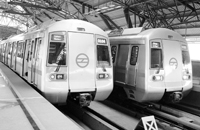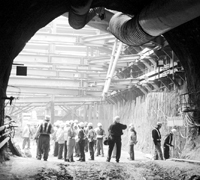Japan's Official Development Assistance White Paper 2007
Column 4 Japanese Customs for Railway in India
— Japanese assistance for the Delhi Metro construction —
In Delhi, the capital city of India, construction efforts for a mass rapid transport system (the Delhi Metro) made up of subway, overland, and elevated railways are progressing at a rapid rate. Historically, railways in India have been a mode of long distance transportation. Until the present, even in the capital city Delhi, neither short distance railways that link the city center with surrounding suburbs nor an inner city railway system have been operated. For this reason, transportation methods in Delhi suburbs are limited to busses and private vehicles; given the constant traffic jams, air pollution has resulted from the high level of emissions. In response to this situation, the Delhi state government is carrying out a construction plan for the Delhi Metro, which is a mass rapid transit system that will be punctual and effective, that will relieve traffic congestion, and lessen the environmental impact.

A completed Delhi Metro station and train (Photo: JBIC)
The Japanese Government has provided a total of approximately ¥162.7 billion in loan aid over six installments beginning in FY1996 for Phase I (totaling approximately 59 kilometers in length) of this project. Operations began for lines totaling nearly 65 kilometers in all sectors in November 2006, and roughly 600,000 city residents per day utilize the lines as of July 2007. Construction of Phase II (totaling approximately 83 kilometers in length) is currently underway for expanding the lines completed in Phase I in order to construct a more convenient transportation network to handle the ever increasing transportation demand. The Japanese Government has also extended loan aid (¥28,483 million by the end of FY2006) to Phase II of the project beginning in FY2005 as well. It is expected that Phase II will be completed in 2011, by which time six railway lines totaling 143 kilometers in length will constitute the core public transportation system within Delhi. For reference purposes, the Tokyo Metro consists of eight lines totaling 183.2 kilometers in length, and the Osaka Municipal Subway consists of eight lines as well, totaling 129.9 kilometers in length.
Japanese consulting firms, construction companies, and trading companies participate in the construction of the Delhi Metro, and Japan's technology and experience is being utilized therein. Previously, the common practice of wearing safety helmets and boots when working had not rooted itself in Indian construction sites. However, upon the instruction of a consulting firm in this project, it has become required for each and every worker to wear safety helmets and boots while they are at the construction site. Moreover, other routine practices from Japanese construction sites have been adopted on the Indian construction site, including separating construction and non-construction areas with signs, using reflective vests and safety belts, and always keeping materials and equipment on the construction site organized. Additionally, the importance of gathering in the morning at a set time to begin work, and abiding by construction deadlines that have been set has been conveyed to the Indian workers.
The Monitoring Group of Citizens on Japan's ODA*1 that visited India in 2004*2 also observed that construction skills from Japan had actually been picked up by locals. Makoto Tomari (then at the Kagoshima Industry Support Center), the head of the group, remarked that, "The train did not shake at all, and it was a pleasant ride. Passengers have expressed that, "I always used the bus, but the train is fast and convenient as there are no traffic jams. I will use the metro from now on." Also, the construction director noted that, "Construction standards from Japan have spread to Indian enterprises, moving towards a unified construction culture." This project is useful in resolving issues faced by Delhi residents, and has provided residents with a safe and comfortable means of transportation. It also generated a unified culture. I believe that the project delivered tremendous results."

Group head Tomari after inspecting the Delhi Metro (Photo: APIC)
Awareness towards safety and efficiency has been spread amongst people working on Indian construction sites through these activities. This project is highly regarded in India domestically and is said to have culturally reformed Indian construction. It is anticipated that this experience will be utilized in future large-scale infrastructure development in India. It is also believed that the development of the Delhi Metro will relieve traffic congestion and reduce vehicle emissions, both issues of concern for Delhi residents. There are high expectations that the Delhi Metro will play a great role in improving the functioning of the city.

A scene of the Delhi Metro under construction (Photo: JBIC)


 Next Page
Next Page